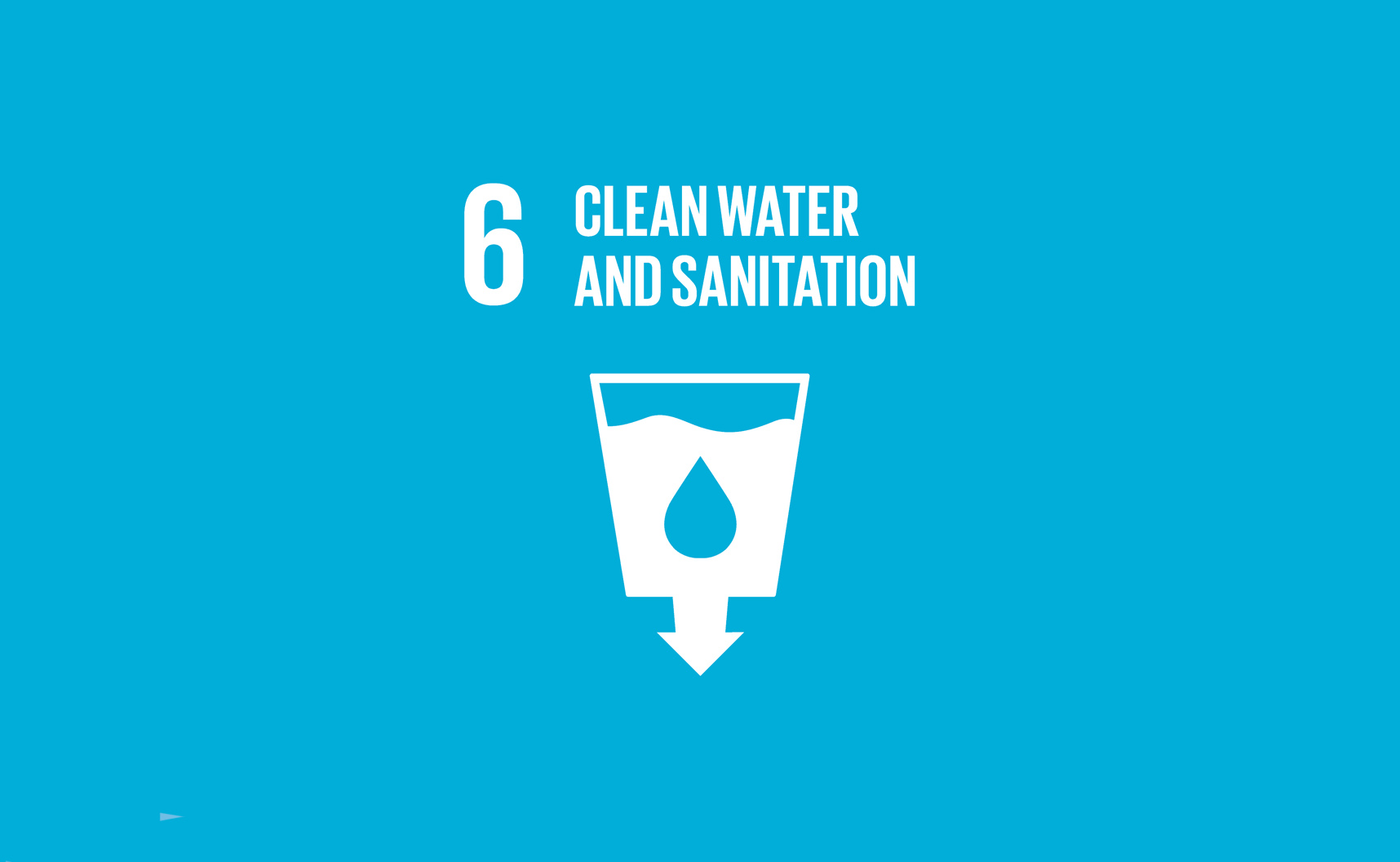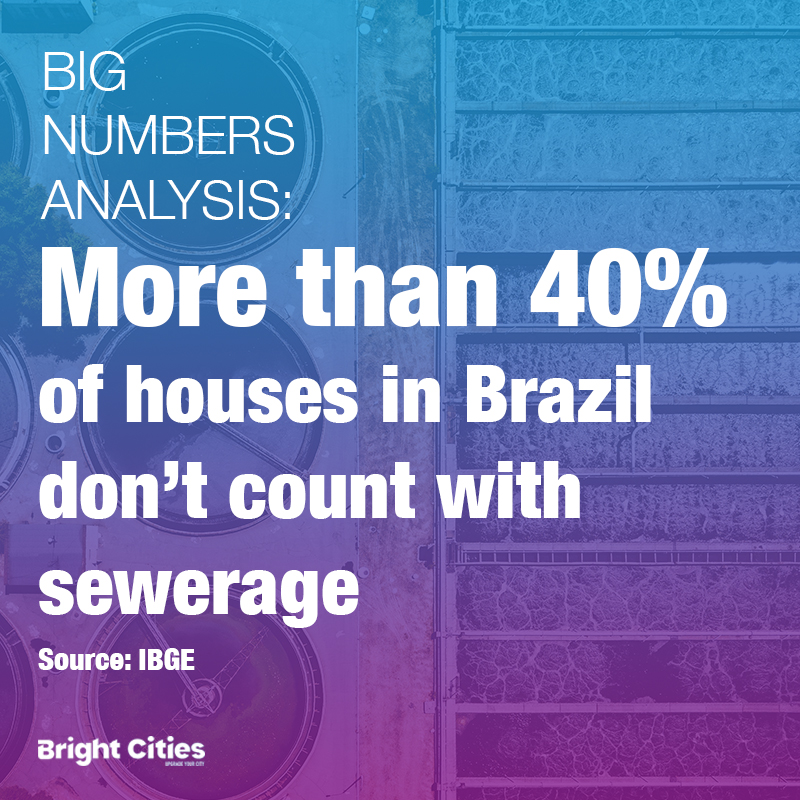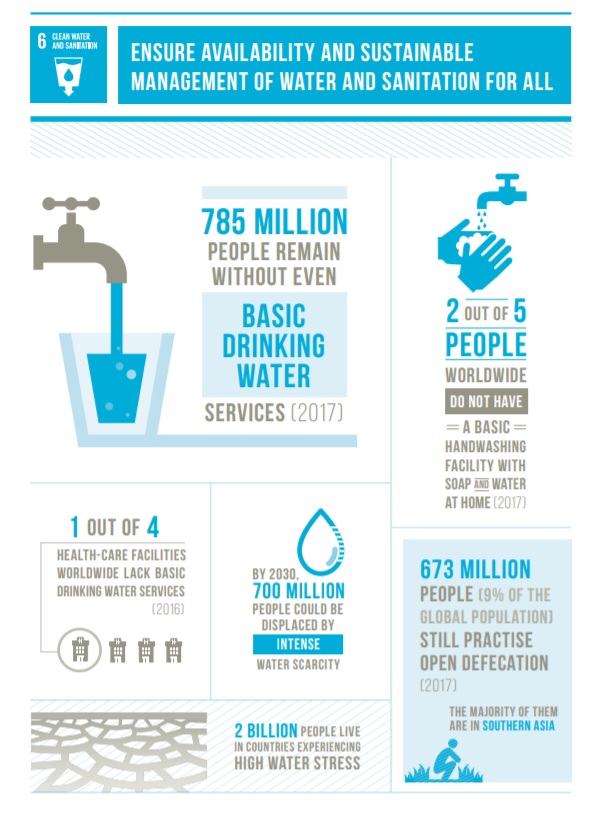Clean, accessible water for all is the sixth objective of the 2030 Agenda

Although essential to life, the access to potable water is still not a guaranteed right for everyone. In addition to that, there is a shortage of basic sanitation services such as sewage, urban cleaning, waste management and drainage of urban rainwater, issues faced mainly by populations in developing countries and / or residents of irregular urban areas.
The challenge we have in our hands is alarming: data released by the UN suggests that if we want to serve the entire planet with clean water and sanitation by 2030, we must double our efforts, starting now. This means that, in practice, we have ten years to reach the sixth of the 17 Sustainable Development Goals, the SDG 6 – Clean water and sanitation. With the mission of “making water and sanitation services available to all in a sustainable way”, the objective is included in the 2030 Agenda for Sustainable Development, a global action plan developed by the UN to guarantee the well-being of people, cities and the planet until the next decade.
But how can we, after all, achieve this goal? To transform this scenario, it is the duty of municipal governments to improve the quality of water and basic sanitation for their population, either through environmental protection measures or through the sustainable management of its resources. Knowing this, Bright Cities offers with its platform an easy and quick way for public managers to diagnose the efficiency of urban services and to find the best solutions to solve them.
With our innovative and exclusive methodology, we use 160 international indicators to evaluate a municipal performance in ten priority areas – such as health, environment, economy and public security, issues related to SDG 6. The lack of drinking water and sanitation directly affects the health of the population, with the spread of parasitic diseases and zoonoses; the environment, given the contamination of rivers, soil, seas and river systems; the public security, since floods are major causes of natural disasters; the economy, since much of the water is used for irrigation; and municipal indexes such as poverty, nutrition and social welfare.
We listed below some of the indicators used by our platform that are directly aligned with SDG 6 – Clean water and sanitation, and explained why our technology is an important tool for managers to identify, evaluate and improve public decision-making:
- Indicators “Total domestic water consumption per capita” and “Total water consumption per capita”: pointing out the average water use by the population and by the city, the indicators reveal whether the resource is being adequately consumed, according to goal 6.4 of SDG 6: “By 2030, substantially increase water-use efficiency across all sectors and ensure sustainable withdrawals and supply of freshwater to address water scarcity and substantially reduce the number of people suffering from water scarcity“;
- Indicators “Average annual hours of water service interruptions” and “Percentage of water loss (unaccounted for water)”: the data collected by the indicators gather fundamental information for managers to evaluate the city’s health services quality and whether the population is being adequately served, as stipulated by goal 6.1 of SDG 6: “By 2030, achieve universal and equitable access to safe and affordable drinking water for all“; and goal 6.5 of SDG 6: “By 2030, implement integrated water resources management at all levels, including through transboundary cooperation as appropriate“;
- Indicators “Percentage of the city’s solid waste that is disposed of in a sanitary landfill” and “Percentage of the city’s solid waste that is recycled”: the data collected by the indicators reveal the city’s capacity to properly handle and treat its waste to avoid damage to the ecosystem, as required by goal 6.6 of SDG 6: “By 2020, protect and restore water-related ecosystems, including mountains, forests, wetlands, rivers, aquifers and lakes“;
- Indicators “Percentage of homes with access to a sewerage system” and “Percentage of untreated sewage”: the indicators show the proportion of families in a given city with access to sanitation services. With these data, municipalities are more able to accurately to reach target 6.3 of SDG 6: “By 2030, improve water quality by reducing pollution, eliminating dumping and minimizing release of hazardous chemicals and materials, halving the proportion of untreated wastewater and substantially increasing recycling and safe reuse globally“.
Based on the collection, analysis and comparison of the data obtained with these indicators, our diagnosis identifies the main challenges and creates, for each city, a personalized roadmap. In it, we point out a series of smart solutions to solve urban problems, with respective costs, deadlines and supplier indications – our platform has a database of more than 1000 smart solutions for smart cities, the largest in the world!
Because we analyze solutions already implemented and with successful impacts in other cities, the initiatives included in our platform offer concrete actions to face many of the urban challenges related to public sanitation, such as rainwater management. After all, in periods of rain and flooding, urban drainage is essential to avoid accidents and ensure the well-being of the population.
One of the indicators used by us is the “Rate of public roads with underground network or river channels in the urban area”. Brazilian cities that stand out in this indicator are Porto Alegre / RS (95.4%) and Curitiba / PR (99.9%), serving as important references for other municipalities. By drawing comparisons not only from Brazil, but also from all over the world, we are able to present cases of benchmarking that have already proved to be possible in other locations. Currently, our database includes Brazil, the United States and 70 other municipalities around the world.
Porto Alegre is one of the three Brazilian cities to charge contribution fees to fund the management and drainage of urban rainwater, also counting with an Urban Drainage Master Plan. For cities where it is not possible to adopt such measures, our platform has alternative and intelligent solutions to face the problem. This is the case of Bueiro Inteligente, already adopted by São Paulo. Based on sensors installed in manholes, the technology allows preventive action in the cleaning of ditches before rains, avoiding overflows. The signal emitted by the sensor indicates when the manhole reaches 70% of its capacity, and promises to reduce operational cleaning costs by up to 51%. In addition, the manholes have a biological larvicide approved by Anvisa, which substantially reduces the proliferation of Aedes Aegypti.
Another smart solution included in our database is Treeparker, aimed at urban tree planting. The initiative create solutions for stormwater runoff management start with trees. With the unlimited expansion for the growth of their roots, the technology allows rainwater runoff at the source, rather than let it run in the sewers.
Although we have made great progress in recent decades, numbers pointed out by the UN state that smart solutions like these can and should be used more by municipalities. Worldwide, the proportion of people with access to potable water rose from 61% to 71% between 2000 and 2015, but has not shown any significant improvement since 2017. In numbers, this shows that 785 million people still lacked a basic drinking water service three years ago. Regarding sanitation, the rates are even more worrying: only 45% of the population used toilets or latrines in 2017, indicating that 701 million people still lived without infrastructure to attend their basic needs.

It is also worth mentioning that children are the main victims of the lack of sanitation and clean water. The UN says that, every day, an average of five thousand children die due to diseases caused by the lack of these basic rights. Poor families are the most affected, especially when we consider that drought exacerbates hunger and malnutrition. With climate change, global leaders are already preparing for the worst: currently, more than 2 billion people live with reduced access to freshwater resources and, by 2050, at least one in four people will likely live in a country affected by chronic or recurrent freshwater shortages.
According to the latest study released by the UN, we still have a long way to go. With effects transversal to the entire 2030 Agenda, including issues of gender, education and health, the scarcity of water, its poor quality and inadequate sanitation have a negative impact on the world:
- 1 in 4 health care facilities lacks basic water services;
- Women and girls are responsible for water collection in 80% of households without access to water on premises;
- Approximately 70% of all water abstracted from rivers, lakes and aquifers is used for irrigation;
- Floods account for 15% of all deaths related to natural disasters;
- In 2017, only 38% in least developed countries had a basic handwashing facility with soap and water at home, leaving an estimated 3 billion people without basic handwashing facilities at home;
- In 2016, one third of all primary schools lacked basic drinking water, sanitation and hygiene services, affecting the education of millions of schoolchildren;
- Of 172 countries, 80 per cent have medium-low implementation or better of integrated water resources management.

In the Brazilian context, data revealed by the IBGE show that 40% of brazilian homes did not have sewage treatment in 2018. Garbage collection was another factor considered in the survey, attesting that 91% of households had access to some type of solid waste collection, while another 8.9% burned waste on the property or gave it another destination. In numbers, this means that a total of 20.1 million Brazilians did not have access to any type of solid waste treatment in 2018.
For the United Nations, overcoming this problem involves understanding the specific needs of each country. In urban areas, the main difficulty are related to irregular settlements, where there is a lack of access to adequate infrastructure and services. The high costs of construction, the absence of technical experts for urban projects and the lack of inspection are other obstacles to be faced. To overcome this challenge, cities like Campinas / SP have adopted water pressure sensors installed in the municipal plumbing network – a smart solution to identify sources of leakage. In rural areas, where water can even be free, issues such as pollution, drought and distance from the collection points, leading users to overcome long journeys, are still frequent difficulties.
But regardless of the scale or urgency of the problem, Bright Cities has the ideal solution to help cities meet urban challenges. Always working in partnership with mayors and public administrations, we have encouraged concrete actions towards the SDGs and we have intensified the collection and use of data for decision making. To learn more about our work, check out the special content we have prepared about our platform. Also, here on our News Platform, you can check out the special content we made about the SDGs, where we address the 17 Goals and tell you what smart solutions suit each one of them!




